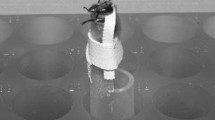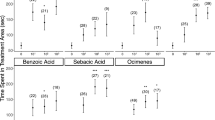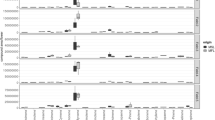Abstract
Previous laboratory studies have shown that diesel exhaust can differentially degrade the volatile organic compounds (VOCs) that constitute floral odors. Furthermore, in proboscis extension response studies honey bees have been shown to have reduced recognition to these degraded floral odors. In this study, we investigated whether flower odors exposed to diesel exhaust reduce foraging in free-flying bees and if flower color influences bees’ behavior. Therefore, we conducted a field study in which honey bees were trained to visit the locations of two arrays of artificial flowers. From the artificial flowers, honey bees were presented with floral VOCs combined with either fresh air or diesel exhaust, through different colored flowers (black, blue, red, and yellow). Honey bee visitation rate did not differ between volatiles delivered with fresh air or with diesel exhaust, suggesting that revisitation of previously rewarding flower patches may be unaffected by air pollution. We also observed a significant interaction between treatment and color: blue flowers were more attractive when volatiles were delivered with diesel exhaust, which was the other way around for red and black and played no role in yellow flowers. Generally, honey bee foraging behavior seemed to be influenced by their previous experiences.



Similar content being viewed by others
Data availability
The datasets generated during and/or analyzed during the current study are available from the corresponding author on reasonable request.
References
Avarguès-Weber A, Giurfa M (2014) Cognitive components of color vision in honey bees: how conditioning variables modulate color learning and discrimination. J Comp Physiol A. https://doi.org/10.1007/s00359-014-0909-z
Blande JD, Holopainen JK, Li T (2010) Air pollution impedes plant-to-plant communication by volatiles. Ecol Lett 13:1172–1181. https://doi.org/10.1111/j.1461-0248.2010.01510.x
Breeze TD, Bailey AP, Balcombe KG, Potts SG (2011) Pollination services in the UK: how important are honeybees? Agric, Ecosyst Environ 142:137–143. https://doi.org/10.1016/j.agee.2011.03.020
Calderone NW (2012) Insect pollinated crops, insect pollinators and US agriculture: trend analysis of aggregate data for the period 1992–2009. PLOS ONE. 7:e37235. https://doi.org/10.1371/journal.pone.0037235
Chittka L, Waser NM (1997) Why red flowers are not invisible to bees. Israel J Plant Sci 45:169–183. https://doi.org/10.1080/07929978.1997.10676682
Chittka L, Raine NE (2006) Recognition of flowers by pollinators. Curr Opin Plant Biol 9:428–435. https://doi.org/10.1016/j.pbi.2006.05.002
Chittka L, Spaethe J, Schmidt A, Hickelsberger A (2001) Adaptation, constraint, and chance in the evolution of flower color and pollinator color vision. In: Thomson JD, Chittka L (eds) Cognitive ecology of pollination: animal behaviour and floral evolution. Cambridge University Press, Cambridge, pp 106–126. https://doi.org/10.1017/CBO9780511542268.007
Dafni A, Lehrer M, Keyan P (1997) Spatial flower parameters and insect spatial vision. Biol Rev 72:239–282. https://doi.org/10.1111/j.1469-185X.1997.tb00014.x
Daumer K (1956) Reizmetrische Untersuchung des Farbensehens der Bienen. Z Vgl Physiol 38:413–478. https://doi.org/10.1007/BF00340456
Dötterl S, Vereecken NJ (2010) The chemical ecology and evolution of bee-flower interactions: a review and perspectives. Can J Zool 88:668–697. https://doi.org/10.1139/Z10-031
Garibaldi LA et al (2013) Wild pollinators enhance fruit set of crops regardless of honey bee abundance. Science 339:1608–1611. https://doi.org/10.1126/science.1230200
Girling RD, Lusebrink I, Farthing E, Newman TA, Poppy GM (2013) Diesel exhaust rapidly degrades floral odours used by honeybees. Sci Rep. https://doi.org/10.1038/Srep02779
Giurfa M (2007) Behavioral and neural analysis of associative learning in the honeybee: a taste from the magic well. J Comp Physiol A 193:801–824. https://doi.org/10.1007/s00359-007-0235-9
Giurfa M, Núñez J, Chittka L, Menzel R (1995) Colour preferences of flower-naive honeybees. J Comp Physiol A 177:247–259. https://doi.org/10.1007/BF00192415
Gumbert A (2000) Color choices by bumble bees (Bombus terrestris): innate preferences and generalization after learning. Behav Ecol Sociobiol 48:36–43. https://doi.org/10.1007/s002650000213
Hill PSM, Wells PH, Wells H (1997) Spontaneous flower constancy and learning in honey bees as a function of colour. Anim Behav 54:615–627. https://doi.org/10.1006/anbe.1996.0467
Hung K-LJ, Kingston JM, Albrecht M, Holway DA, Kohn JR (2018) The worldwide importance of honey bees as pollinators in natural habitats. Proc R Soc B 285:20172140. https://doi.org/10.1098/rspb.2017.2140
Knudsen J, Eriksson R, Gershenzon J, Ståhl B (2006) Diversity and distribution of floral scent. Bot Rev 72:1–120. https://doi.org/10.1663/0006-8101(2006)72[1:DADOFS]2.0.CO;2
Lenth RV (2016) Least-Squares Means: The R Package lsmeans. J Stat Softw 69(1):1–33. https://doi.org/10.18637/jss.v069.i01
Lusebrink I, Girling RD, Farthing E, Newman TA, Jackson CW, Poppy GM (2015) The effects of diesel exhaust pollution on floral volatiles and the consequences for honey bee olfaction. J Chem Ecol 41:904–912. https://doi.org/10.1007/s10886-015-0624-4
McFrederick QS, Kathilankal JC, Fuentes JD (2008) Air pollution modifies floral scent trails. Atmos Environ 42:2336–2348. https://doi.org/10.1016/j.atmosenv.2007.12.033
Menzel R (1967) Untersuchungen zum Erlernen von Spektralfarben durch die Honigbiene (Apis mellifica). Z Vgl Physiol 56:22–62. https://doi.org/10.1007/BF00333562
Menzel R (1985) Learning in honey bees in an ecological and behavioral context. Fortschr Zool 31:55–74
Menzel R (1999) Memory dynamics in the honeybee. J Comp Physiol A 185:323–340. https://doi.org/10.1007/s003590050392
Peitsch D, Fietz A, Hertel H, de Souza J, Ventura DF, Menzel R (1992) The spectral input systems of hymenopteran insects and their receptor-based colour vision. J Comp Physiol A 170:23–40. https://doi.org/10.1007/BF00190398
Pinheiro J, Bates D, R Core Team (2022) nlme: Linear and nonlinear mixed effects models. R package version 3.1-161. https://CRAN.R-project.org/package=nlme
Raguso RA (2008) Wake up and smell the roses: the ecology and evolution of floral scent. Annu Rev Ecol Evol Syst 39:549–569. https://doi.org/10.1146/annurev.ecolsys.38.091206.095601
Reilly J, Artz D, Biddinger D, Bobiwash K, Boyle N, Brittain C, Brokaw J, Campbell J, Daniels J, Elle E (2020) Crop production in the USA is frequently limited by a lack of pollinators. Proc R Soc B 287:20200922. https://doi.org/10.1098/rspb.2020.0922
Reisenman CE, Giurfa M (2008) Chromatic and achromatic stimulus discrimination of long wavelength (red) visual stimuli by the honeybee Apis mellifera. Arthropod-Plant Interact 2:137–147. https://doi.org/10.1007/s11829-008-9041-8
Reitmayer CM, Ryalls JMW, Farthing E, Jackson CW, Girling RD, Newman TA (2019) Acute exposure to diesel exhaust induces central nervous system stress and altered learning and memory in honey bees. Sci Rep 9:5793. https://doi.org/10.1038/s41598-019-41876-w
Reser DH, Wijesekara Witharanage R, Rosa MGP, Dyer AG (2012) Honeybees (Apis mellifera) learn color discriminations via differential conditioning independent of long wavelength (green) photoreceptor modulation. PLoS ONE 7:e48577. https://doi.org/10.1371/journal.pone.0048577
Riffell JA, Shlizerman E, Sanders E, Abrell L, Medina B, Hinterwirth AJ, Kutz JN (2014) Flower discrimination by pollinators in a dynamic chemical environment. Science 344:1515–1518. https://doi.org/10.1126/science.1251041
Ryalls JMW, Langford B, Mullinger NJ, Bromfield LM, Nemitz E, Pfrang CP, Girling RD (2022) Anthropogenic air pollutants reduce insect-mediated pollination services. Environ Pollut 297:118847. https://doi.org/10.1016/j.envpol.2022.118847
Saunier A, Blande JD (2019) The effect of elevated ozone on floral chemistry of Brassicaceae species. Environ Pollut 255:113257. https://doi.org/10.1016/j.envpol.2019.113257
Stuurman J, Hoballah ME, Broger L, Moore J, Basten C, Kuhlemeier C (2004) Dissection of floral pollination syndromes in petunia. Genetics 168:1585–1599. https://doi.org/10.1534/genetics.104.031138
Wright GA, Schiestl FP (2009) The evolution of floral scent: the influence of olfactory learning by insect pollinators on the honest signalling of floral rewards. Funct Ecol 23:841–851. https://doi.org/10.1111/j.1365-2435.2009.01627.x
Acknowledgements
Special thanks go to Martin Fischlechner for the introduction to laser cutting and Przemyslaw Ociepa for loaning us his Hitachi camcorder.
Funding
Funding for this research has been provided through the Leverhulme Trust Research Project Grant RPG-089.
Author information
Authors and Affiliations
Contributions
RDG, TAN and GMP conceived the study. IL designed the artificial flower setup and conducted the experiment. IL and LD performed the analysis and wrote the manuscript. CWJ took the UV–VIS measurements and UV pictures. All authors discussed the results and commented on the manuscript.
Corresponding author
Ethics declarations
Conflict of interest
The authors declare no conflicts of interest.
Additional information
Handling Editor: Jarmo K. Holopainen.
Publisher's Note
Springer Nature remains neutral with regard to jurisdictional claims in published maps and institutional affiliations.
Supplementary Information
Below is the link to the electronic supplementary material.
Rights and permissions
Springer Nature or its licensor (e.g. a society or other partner) holds exclusive rights to this article under a publishing agreement with the author(s) or other rightsholder(s); author self-archiving of the accepted manuscript version of this article is solely governed by the terms of such publishing agreement and applicable law.
About this article
Cite this article
Lusebrink, I., Girling, R.D., Dobrindt, L. et al. Investigating the effects of diesel exhaust and flower color on flower visitation by free-flying honey bees. Arthropod-Plant Interactions 17, 11–17 (2023). https://doi.org/10.1007/s11829-022-09941-w
Received:
Accepted:
Published:
Issue Date:
DOI: https://doi.org/10.1007/s11829-022-09941-w




